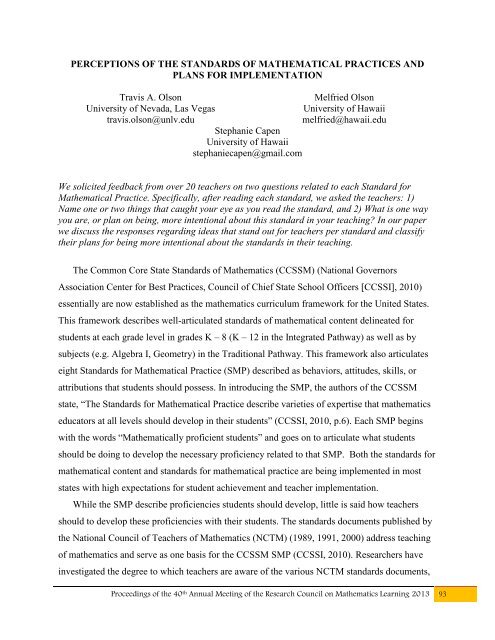2013 Conference Proceedings - University of Nevada, Las Vegas
2013 Conference Proceedings - University of Nevada, Las Vegas
2013 Conference Proceedings - University of Nevada, Las Vegas
- No tags were found...
Create successful ePaper yourself
Turn your PDF publications into a flip-book with our unique Google optimized e-Paper software.
PERCEPTIONS OF THE STANDARDS OF MATHEMATICAL PRACTICES ANDPLANS FOR IMPLEMENTATIONTravis A. Olson<strong>University</strong> <strong>of</strong> <strong>Nevada</strong>, <strong>Las</strong> <strong>Vegas</strong>travis.olson@unlv.eduStephanie Capen<strong>University</strong> <strong>of</strong> Hawaiistephaniecapen@gmail.comMelfried Olson<strong>University</strong> <strong>of</strong> Hawaiimelfried@hawaii.eduWe solicited feedback from over 20 teachers on two questions related to each Standard forMathematical Practice. Specifically, after reading each standard, we asked the teachers: 1)Name one or two things that caught your eye as you read the standard, and 2) What is one wayyou are, or plan on being, more intentional about this standard in your teaching? In our paperwe discuss the responses regarding ideas that stand out for teachers per standard and classifytheir plans for being more intentional about the standards in their teaching.The Common Core State Standards <strong>of</strong> Mathematics (CCSSM) (National GovernorsAssociation Center for Best Practices, Council <strong>of</strong> Chief State School Officers [CCSSI], 2010)essentially are now established as the mathematics curriculum framework for the United States.This framework describes well-articulated standards <strong>of</strong> mathematical content delineated forstudents at each grade level in grades K – 8 (K – 12 in the Integrated Pathway) as well as bysubjects (e.g. Algebra I, Geometry) in the Traditional Pathway. This framework also articulateseight Standards for Mathematical Practice (SMP) described as behaviors, attitudes, skills, orattributions that students should possess. In introducing the SMP, the authors <strong>of</strong> the CCSSMstate, “The Standards for Mathematical Practice describe varieties <strong>of</strong> expertise that mathematicseducators at all levels should develop in their students” (CCSSI, 2010, p.6). Each SMP beginswith the words “Mathematically pr<strong>of</strong>icient students” and goes on to articulate what studentsshould be doing to develop the necessary pr<strong>of</strong>iciency related to that SMP. Both the standards formathematical content and standards for mathematical practice are being implemented in moststates with high expectations for student achievement and teacher implementation.While the SMP describe pr<strong>of</strong>iciencies students should develop, little is said how teachersshould to develop these pr<strong>of</strong>iciencies with their students. The standards documents published bythe National Council <strong>of</strong> Teachers <strong>of</strong> Mathematics (NCTM) (1989, 1991, 2000) address teaching<strong>of</strong> mathematics and serve as one basis for the CCSSM SMP (CCSSI, 2010). Researchers haveinvestigated the degree to which teachers are aware <strong>of</strong> the various NCTM standards documents,<strong>Proceedings</strong> <strong>of</strong> the 40 th Annual Meeting <strong>of</strong> the Research Council on Mathematics Learning <strong>2013</strong> 93




